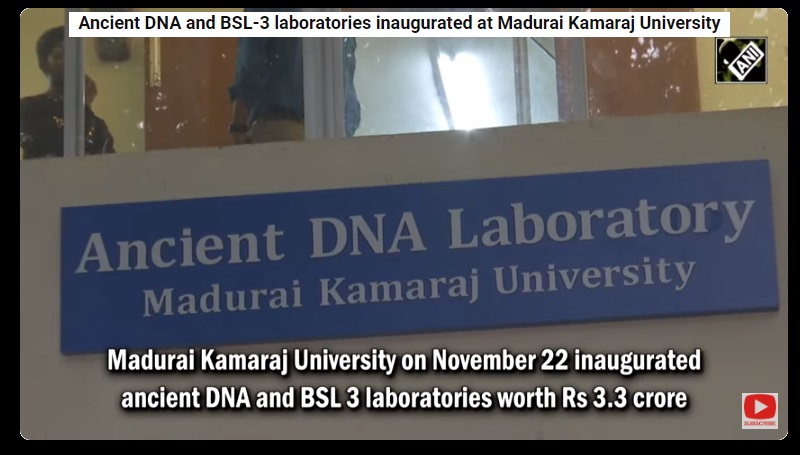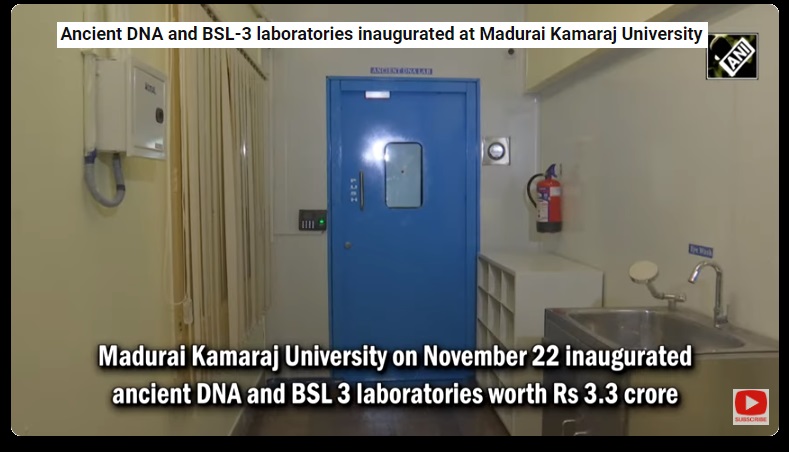Antiquity and Peopling of the Deccan – an Ancient DNA approach – RUSA project – from Archaeology to Technology (2)

Project Title: Antiquity and Peopling of the Deccan – an Ancient DNA approach: The MKU-RUSA supported research project entitled “Antiquity and Peopling of the Deccan – an Ancient DNA approach”, to work in a collaborative venture between the Dept. of Archaeology, Govt. of Tamil Nadu and School of Biological Sciences, Madurai Kamaraj University[1]. As most of the archaeological sites have been near to Madurai, MKU might have chosen for the research and setting up the laboratory. Rashtriya Uchchatar Shiksha Abhiyan (RUSA) is a Centrally Sponsored Scheme (CSS), launched in 2013 aims at providing strategic funding to eligible state higher educational institutions. The central funding (in the ratio of 60:40 for general category States, 90:10 for special category states and 100% for union territories) would be norm-based and outcome dependent. The funding would flow from the central ministry through the state governments/union territories to the State Higher Education Councils before reaching the identified institutions. The funding to states would be made on the basis of a critical appraisal of State Higher Education Plans, which would describe each state’s strategy to address issues of equity, access and excellence in higher education. Yet, the states blaming the Centre for the sanctioning and allocation of funds is noted very often.

Department of Genetics Madurai Kamaraj University: Department of Genetics was established in 1990. The former heads of the Department were –
- Prof. T. J. Panidan,
- Prof. S. Mathavan and
- Prof. P. Gunasekaran.
Cancer Genetics and Microbial Genetics are the broad research areas of the Department, at present. Complex regulations in cancer cells and microbes have been investigated with molecular genetics, genomics and proteomice since 1990, 45 major research projects were completed by the former and current faculty members of the Genetic Department and 55 Ph.D students were awarded from the Department. At present, there are 7 major projects being investigated in the Department with the support of DBT, DST, ICMR, and UGC. Cancer Genetics Laboratory in the Department of Genetics is focusing on understanding the altered signalling pathways and their regulation In gastric, liver and breast §§J1§#F§ to recognize therapeutically vulnerable targets. So, now it is evident that the department has turned towards genetic studies in a different manner focused on the people of the ancient Tamilgam.

MKU ancient DNA research oriented to TN Archaeology: Dr. Kumaresan is involved in investigating ancient genomics of the archaeological human, animal, plant, and bacterial remains from the archaeological excavations of Dept. of Archaeology, Government of TamilNadu, India[2]. The Ancient DNA Program of MKU is progressing in the following aspects:
- Ancient Human DNA Analysis,
- Animal DNA Analysis,
- Plant DNA Analysis,
- Sedimental DNA analysis,
- Microbial DNA Analysis,
- Organic Molecular Analysis,
- Proteomics, etc.
The human and animal skeletal and floral remains from Keeladi, Kondagai, Adichanallur, Sivagalai, Kodumanal and Mayiladumparai are investigated in genomic contexts with the contemporary modern and ancient genomes across the globe to understand the ancient biology as well as to provide biological evidence to the scientific missions of the Archaeology Department of Govt. of Tamil Nadu. Here, how the genetic experts would deal with Dravidian, non-Dravidian or Aryan categories has to be noted carefully. It has already been pointed out that Pitchappan has already talked about the Dravidian category.

Ancient DNA Lab was inaugurated in November 2022: The lab, which was inaugurated in November 2022, has begun preliminary work on conducting ancient DNA analysis on human, animal, and plant samples collected by the Tamil Nadu State Department of Archaeology (TNSDA) and ASI[3]. According to a press statement from the university, the main objective of the Ancient DNA lab was to generate and analyze DNA data from the archaeological excavations of Tamil Nadu. The lab had been established following the models at the University of Chicago and Birbal Sahni Institute of Palaeosciences, Lucknow[4]. Professor G Kumaresan, Head, Department of Genetics, School of Biological Sciences, MKU, “We have begun the dry run. The samples are expectedly contaminated because they remained buried deep for centuries together. We are now being assisted by the Harvard team in extracting DNA from the human samples with minimal damage,” told to DH. “The team is helping us with the techniques they have successfully followed so far,” Kumaresan added. Kendra Sirak, of David Reich Lab of the prestigious Harvard Medical School, US who has so far analyzed 500 DNA samples, is an expert in extracting DNA without disturbing the skull much and lessons from her will only help those at the MKU lab learn the tricks of the trade.

DNA tests to corroborate people with Sangam period: DNA is extracted mainly from teeth and petrous bones of the human samples which is used as the primary input. “DNA is generally extracted from Calculus bone and from the root of the teeth. The extracted portion is then processed and computationally analysed. We will then compare the data of ancient DNA with global data to understand migration (of people) and the linkages with global populations,” Kumaresan added. Sirak said her team was excited to collaborate with MKU team to study DNA from people who lived in Tamil Nadu long ago. “We will combine our expertise in hopes to generate authentic ancient DNA sequences that will help us to learn more about this very important part of India,” she told DH. The results of the DNA analysis generated by the MKU lab will be cross-checked by the Harvard team to ensure that the findings are right and questions are not raised over them since the samples are contaminated with bacterial DNA. The results will then be compared with thousands of ancient and modern human genomes across the globe to explain in detail the ancient human migration and will be corroborated with Sangam Literature wherever possible. Thus, it is evident that goal has been set before the research to start, samples to come from the sites, they are to be tested in the newly set up laboratory etc.

Lab could test all biological samples: Apart from ancient DNA, the MKU team is also exploring the proteins from skeletal remains and organic molecules from the potsherds of the offering pots. Some of the molecules retrieved so far includes Floxuridine (rice), Orotic Acid (milk), Myristic Acid (myristica), Ricinoleic Acid (castor) and cholesterol (animal fats). The MKU lab has already sequenced about 1500 millions of DNA fragments from 20 samples of humans, animals, and plants. The DNA collected from the samples will help understand the agricultural and trade practices, while the organic molecular analysis would reveal the agricultural, cultural, and social practices in Tamil Nadu during 500 BCE – 2500 BCE. The retrieval of rice is significant as pollen analyses of samples from the first phases of excavations in Keeladi found that excess production of rice contributed to the growth of the urban city while fertile land played “an active role” for the evolution of the habitation. The excess production of rice prompted the settlers to set sail in the seas to far-away lands that are chronicled in several literatures, the ASI report, which is yet to be made public, says. The non-publication of excavation reports has been a drawback not only for the excavators, but also for the researchers, as they could not quote the findings for their reference. Therefore, the excavating groups, concerned departments and authorities should take the initiative to publish the reports within a reasonable time.

What Romila Thapar says about genetic studies[5]: Romila Thapar has pointed out the following in the context of genetic studies:
- It is assumed that genetic analyses can provide some evidence of human population origins and social history in India. But so far, the results have been contradictory, and historians find it difficult to use them with any certitude.
- Race as a category is unknown to traditional Indian classifications. It was imported from Britain and was used mainly by Europeans writing on Indian society, although subsequently it came to be used by Indians as well.
- Attempts have been made recently to determine the identity of the so-called “Aryans” as components of the Indian population by using DNA analysis. This is largely to ascertain whether they were indigenous to India or were foreign arrivals.
- Similar attempts have been made to trace the origins of caste groups on the basis of varna identities and record their distribution. The results so far have been contradictory and, therefore, not of much help to social historians.
- There are problems in the defining of categories and the techniques of analysis.
- Aryan is a linguistic and cultural category and not a biological one.
- Caste groups have no well-defined and invariable boundaries despite marriage codes. Various other categories have been assimilated into particular castes as part of the evolution of social history on the subcontinent.
© K. V. Ramakrishna Rao
18-06-2024

[1] Antiquity of peopling of Deccan – An ancient DNA approach with grant nurnber MKU-RUSA/2020/48.
[2] Ancient Genomics of the Archaeological remains of Tamil Nadu – https://mkuniversity.ac.in/new/school/sbs/kumaresan.php
[3] The Hindu, Ancient DNA and BSL 3 laboratories inaugurated in Madurai Kamaraj University, THE HINDU BUREAU, Published – November 17, 2022 10:42 pm IST – MADURAI; Updated – November 18, 2022 11:28 am IST.
[4] https://www.thehindu.com/news/cities/Madurai/ancient-dna-and-bsl-3-laboratories-inaugurated-in-madurai-kamaraj-university/article66150429.ece – :~:text=According%20to%20a%20press%20statement,Sahni%20Institute%20of%20Palaeosciences%2C%20Lucknow.
[5] Thapar, Romila. “Can genetics help us understand Indian social history?.” Cold Spring Harbor Perspectives in Biology 6.11 (2014): a008599.

Filed under: africa, Ariyar, DNA, Dramila, Dravida, Dravidam, dravidar, Dravidi, Dravidian, dravidian model, dravidian monkey, dravidian stock, gender, gene, genetic studies, genetic stutudies, genetics, genography, geo-archaeology, geoarchaeology, historicity, historiography, historiosophy, history, indus script, indus symbol, indus valley, nationalism, nationality, neolithic, non-Veddc, non-Vedic, ontology, paleobotanical research, paleolithic, race, racialism, racism, RSS, rusa, Sangam, Sanskrit, sanskrit, sanskrit language, sectarian, sectarianism, sivapithecus, siwalik, skeletal remains, skeleton, skeleton export, skull, skull export, submerged, tamil, Tamil Brahmi, tamil chauvinism, Tamil inscription, tamil monkey, tamil sectarianism, tamil separatism, tamili, tamilnadu, transmigration, update, updating, Veda, Vedas, vedic chronology, xenophobia | Tagged: archaeology, arya, aryan, aryan blood, aryan invasion, aryan myth, aryan problem, aryan race, bio-genetics, biology, DNA, Dramila, dravid, Dravida, Dravidam, dravidan, Dravidar, Dravidi, Dravidian, dravidian model, dravidian race, dravidian stock, dravidianism, Dravidians, gender, gene, genetic studies, genetics, migration, neanderthals, out of africa, pure race, race, racialism, racism, science, transmigration | Leave a comment »







